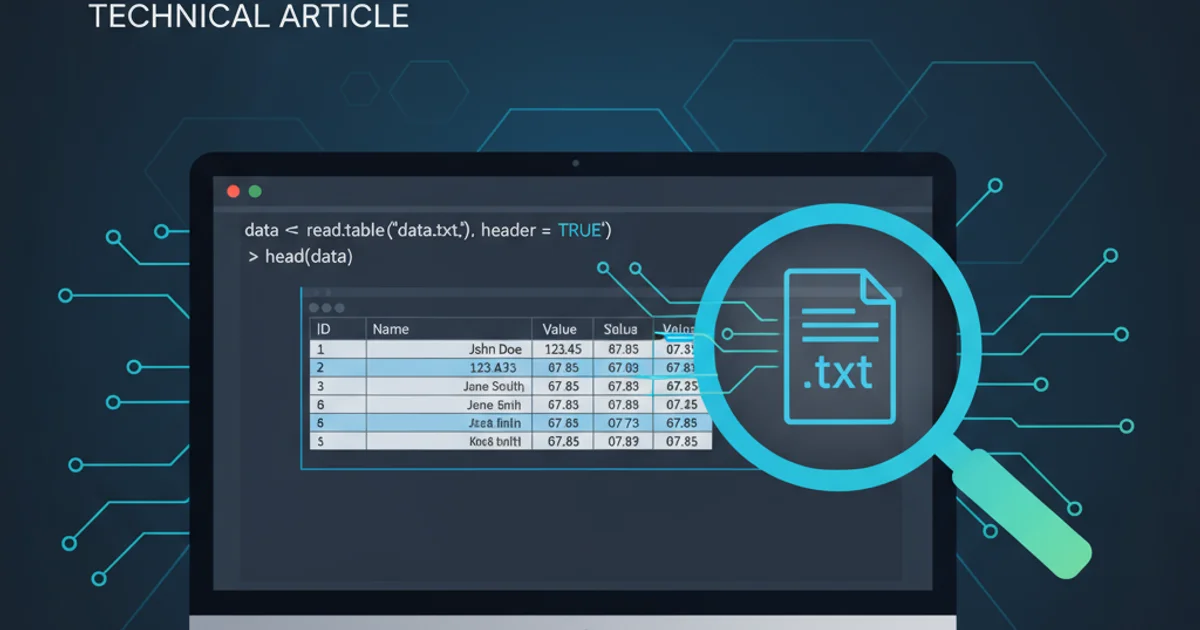How can I import a .txt file in R to be read?
Categories:
Importing Text Files in R: A Comprehensive Guide

Learn how to effectively import and read various types of text files (.txt, .csv, etc.) into R for data analysis, covering common functions, parameters, and best practices.
Importing data is the first crucial step in any data analysis workflow in R. Text files, such as .txt or .csv (Comma Separated Values), are among the most common formats for storing tabular data. R provides a robust set of functions to handle these files, allowing you to load your data into data frames for further manipulation and analysis. This article will guide you through the essential methods for importing text files, explaining key parameters and common pitfalls.
Understanding Your Text File Structure
Before importing, it's vital to understand the structure of your text file. Key aspects include the delimiter, whether it has a header row, how missing values are represented, and if there are any comments. This understanding will dictate which R function and parameters you choose. A common mistake is assuming a file is comma-separated when it might be tab-separated, leading to a single-column import.
flowchart TD
A[Start: Identify File] --> B{File Type?}
B -- .csv --> C[Use read.csv()]
B -- .txt (delimited) --> D[Use read.delim() or read.table()]
B -- .txt (fixed width) --> E[Use read.fwf()]
C --> F{Header?}
D --> F
E --> F
F -- Yes --> G[Set header=TRUE]
F -- No --> H[Set header=FALSE]
G --> I{Delimiter?}
H --> I
I -- Comma --> J[Set sep=","]
I -- Tab --> K[Set sep="\t"]
I -- Other --> L[Set sep="char"]
J --> M{Missing Values?}
K --> M
L --> M
M -- Yes --> N[Set na.strings="value"]
M -- No --> O[Proceed]
N --> P[End: Data Imported]
O --> PDecision flow for importing text files into R.
Basic Import Functions: read.table(), read.csv(), and read.delim()
R's base package offers several functions for reading tabular data. The most versatile is read.table(), which can handle various delimiters. read.csv() and read.delim() are specialized wrappers around read.table() for comma-separated and tab-separated files, respectively, with some default parameters pre-set for convenience.
# Example 1: Importing a basic CSV file
data_csv <- read.csv("my_data.csv", header = TRUE, stringsAsFactors = FALSE)
# Example 2: Importing a tab-separated text file
data_txt <- read.delim("my_data.txt", header = TRUE, stringsAsFactors = FALSE)
# Example 3: Using read.table for a custom delimiter (e.g., semicolon)
data_semicolon <- read.table("my_data_semicolon.txt", sep = ";", header = TRUE, stringsAsFactors = FALSE)
# View the first few rows of the imported data
head(data_csv)
str(data_csv)
Basic examples of importing data using read.csv(), read.delim(), and read.table().
stringsAsFactors = FALSE when importing data unless you specifically need character columns to be converted to factors. This prevents R from automatically converting text into factors, which can lead to unexpected behavior and errors in later analysis.Advanced Parameters and Best Practices
Beyond the basic header and sep arguments, read.table() and its variants offer many other parameters to handle complex file structures. Understanding these can save you significant data cleaning time.
# Example 4: Handling missing values and comments
data_advanced <- read.table(
"advanced_data.txt",
sep = ",",
header = TRUE,
na.strings = c("NA", "", "NULL"), # Specify multiple strings to be treated as NA
comment.char = "#", # Ignore lines starting with '#'
skip = 2, # Skip the first 2 lines of the file
stringsAsFactors = FALSE
)
head(data_advanced)
Using na.strings, comment.char, and skip for more complex file imports.
data.table (e.g., fread()) or readr (e.g., read_csv()). These packages are often significantly faster and more memory-efficient than base R functions for large datasets.1. Place your file in the working directory
Ensure your .txt or .csv file is in your R working directory, or provide the full path to the file. You can check your current working directory with getwd() and set it with setwd("path/to/directory").
2. Inspect the file manually
Open the file in a text editor (like Notepad, VS Code, or Sublime Text) to visually inspect its structure. Look for the delimiter, header presence, and how missing values are represented. This step is crucial for choosing the correct R function and parameters.
3. Choose the appropriate R function
Based on your inspection, select read.csv(), read.delim(), or read.table(). For fixed-width files, read.fwf() is the go-to. For very large files, consider fread() from data.table or read_csv() from readr.
4. Specify key parameters
At a minimum, define header (TRUE/FALSE) and sep (delimiter character). Also, consider na.strings for missing values, comment.char for comments, and stringsAsFactors = FALSE for character columns.
5. Import and verify
Execute the import command. Then, use functions like head(), str(), summary(), and dim() to verify that the data has been imported correctly and has the expected structure and dimensions.